daytraderrockstar
Junior member
- Messages
- 10
- Likes
- 0
I am looking for more downside Before we move back up and take out the highs. I understand and respect the market enough to know not to impose my will on it. Meaning I can not predict what will happen next week and neither can anyone else. This is my Saying "I have been in the market long enough to have experience everything that has happened in that time, but I haven't experience things that haven't happened." So In this weeks video watch list I go over the many levels underneath us (3) that if we moved down to them I expect to be some trade opportunities and those same levels will be the level I would look to cover any shorts I have at that time. The shorts will come in most likely in the form of a short on the $SPX either though the SPXU, or SPY short or Puts in the SPY. I feel this will be the best strategy for me If I want to defend my current longs as I think I am close to great levels on them and I also expect the markets to move higher after this pullback (Also this could be setting up for a very nice wide flag).
So some hedges with the longs and expecting to take possible 2 positions off.
Also want to play attention to any big candles that play out next week.
The main signal the last week was the rising wedge pattern that was developing and pretty much matured enough to expect a breakdown from it, which is what is expected from it. You been hearing a lot more about falling wedges the rising wedges lately we just had a great falling wedge in IBM a few weeks ago and it was even perfect to the point of its measured move target
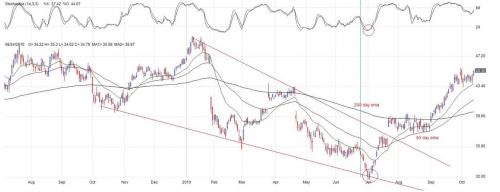
Chart 1 Larger Image View
So rising wedges are not as common and in most cased falling wedges are continuation patterns in a greater uptrend. So this rising wedge is definitely not a pullback in a larger downtrend. This is where i would like to trade a rising wedge. Either way this looks like a good wedge and it does look like we have some more pullback coming.
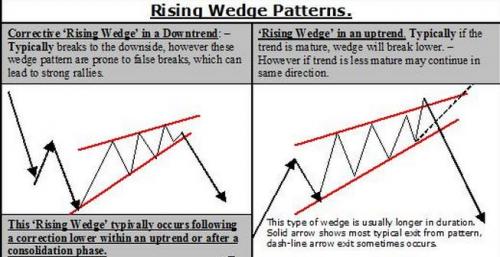
I just recently wrote up some notes on wedges and even though the examples are mostly with falling wedges you just have to reverse the rules for rising wedges. The wedge is one of my favorite patterns.
Wedge Patterns: You can have 3 different wedges. First is my favorite to trade the Falling Wedge which has a bullish bias to it. The rising Wedge is just the opposite and with a negative bias and finally the symmetrical triangle which has no directional slope and no bullish or bearish bias on its own merit.
Lets start off with some great examples of what a proper wedge looks like. 2 Lines form this pattern and there is a few key points to look for. Not all falling wedges are equal and just like 1-2-3 Patterns over time you will get a feel for the angles of the 2 lines. In a falling wedge the upper downtrend line (resistance) and the lower (support) line are in a process to converge at a point in the distant future. This convergence should not happen and you want to see the lower support line at less of an angle to the top trend line The chart will play out with the stock making new lower lows but this penetration becomes shallower. Shallower lows indicate a decrease in selling pressure and create a lower support line with less negative slope than the upper resistance line.
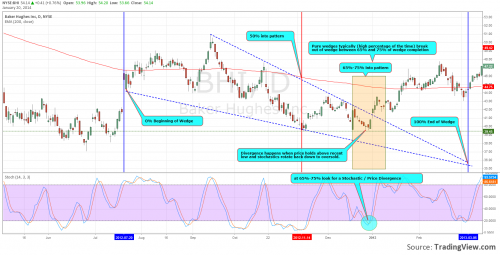
Chart 2
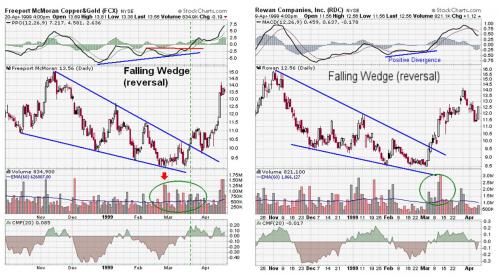
Chart 3
DayTraderRockStar Tip
Trading Patterns for close to 20 years has made me aware of some very profitable scenarios that play out in the market. One of these involves trading the falling wedge pattern. Once you think you identified a valid wedge pattern rising or falling (not symmetrical). Take the 2 trend lines that are slowly converging and extend those trend lines out till they meet. They break down the chart by placing a line at the beginning of the pattern and where the trend lines will eventually converge and then go back and but a vertical line right in the middle of the pattern representing the 50% mark. Now put a line between the middle and the end and that will represent the 75% zone. This is a excellent gauge on when and where the wedge will break out. The area is between 65%-75% in the wedge.
Try to take the trade closest to the lower trend line in a falling wedge and closest to the top trend line in a rising wedge.
Important to watch the stochastics here to as you want to see a divergence happen or at least get a good rotation back up and momentum to start gaining to the upside.
Thanks it for now have a great weekend
DayTraderRockStar
$IBM chart: IBM Wedge Retracement
https://www.tradingview.com/v/e2Xw8EIM/
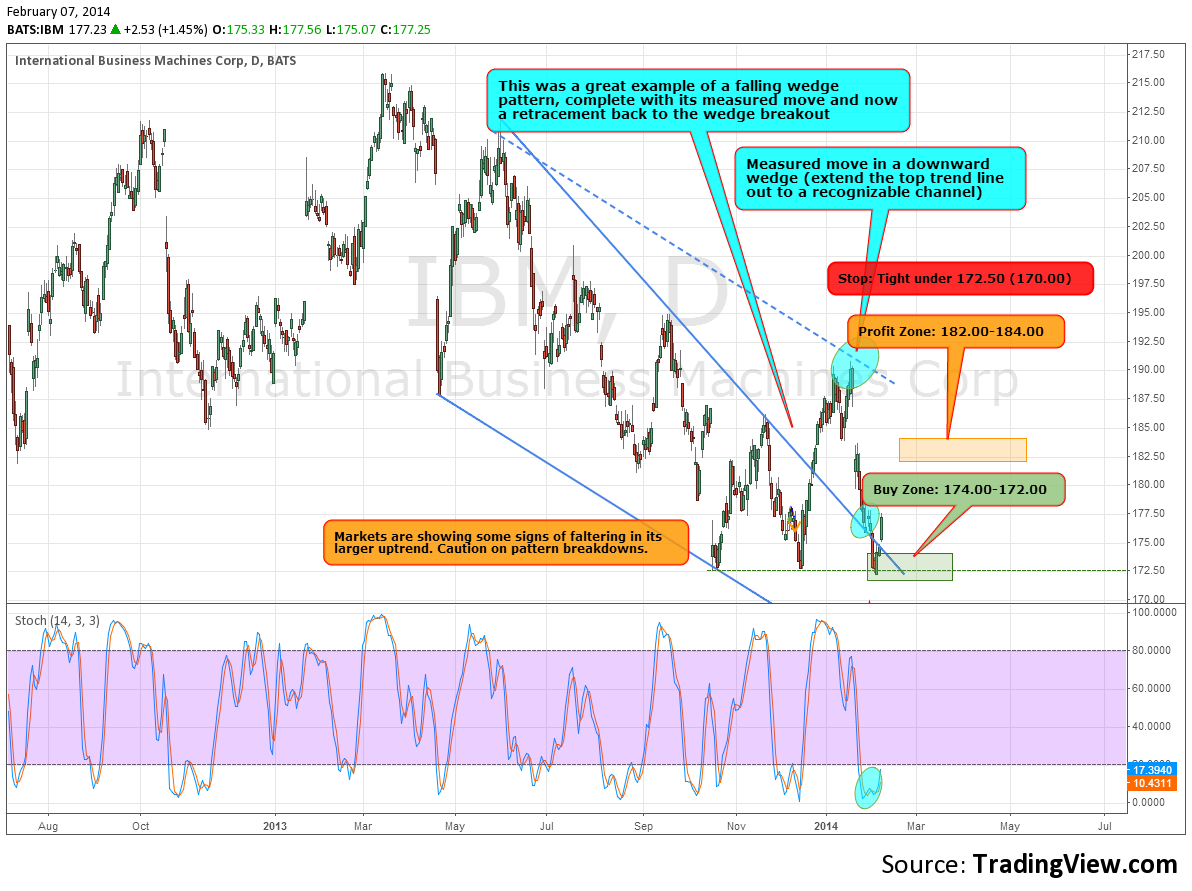
So some hedges with the longs and expecting to take possible 2 positions off.
Also want to play attention to any big candles that play out next week.
The main signal the last week was the rising wedge pattern that was developing and pretty much matured enough to expect a breakdown from it, which is what is expected from it. You been hearing a lot more about falling wedges the rising wedges lately we just had a great falling wedge in IBM a few weeks ago and it was even perfect to the point of its measured move target

Chart 1 Larger Image View
So rising wedges are not as common and in most cased falling wedges are continuation patterns in a greater uptrend. So this rising wedge is definitely not a pullback in a larger downtrend. This is where i would like to trade a rising wedge. Either way this looks like a good wedge and it does look like we have some more pullback coming.

I just recently wrote up some notes on wedges and even though the examples are mostly with falling wedges you just have to reverse the rules for rising wedges. The wedge is one of my favorite patterns.
Wedge Patterns: You can have 3 different wedges. First is my favorite to trade the Falling Wedge which has a bullish bias to it. The rising Wedge is just the opposite and with a negative bias and finally the symmetrical triangle which has no directional slope and no bullish or bearish bias on its own merit.
Lets start off with some great examples of what a proper wedge looks like. 2 Lines form this pattern and there is a few key points to look for. Not all falling wedges are equal and just like 1-2-3 Patterns over time you will get a feel for the angles of the 2 lines. In a falling wedge the upper downtrend line (resistance) and the lower (support) line are in a process to converge at a point in the distant future. This convergence should not happen and you want to see the lower support line at less of an angle to the top trend line The chart will play out with the stock making new lower lows but this penetration becomes shallower. Shallower lows indicate a decrease in selling pressure and create a lower support line with less negative slope than the upper resistance line.

Chart 2

Chart 3
DayTraderRockStar Tip
Trading Patterns for close to 20 years has made me aware of some very profitable scenarios that play out in the market. One of these involves trading the falling wedge pattern. Once you think you identified a valid wedge pattern rising or falling (not symmetrical). Take the 2 trend lines that are slowly converging and extend those trend lines out till they meet. They break down the chart by placing a line at the beginning of the pattern and where the trend lines will eventually converge and then go back and but a vertical line right in the middle of the pattern representing the 50% mark. Now put a line between the middle and the end and that will represent the 75% zone. This is a excellent gauge on when and where the wedge will break out. The area is between 65%-75% in the wedge.
Try to take the trade closest to the lower trend line in a falling wedge and closest to the top trend line in a rising wedge.
Important to watch the stochastics here to as you want to see a divergence happen or at least get a good rotation back up and momentum to start gaining to the upside.
Thanks it for now have a great weekend
DayTraderRockStar
$IBM chart: IBM Wedge Retracement
https://www.tradingview.com/v/e2Xw8EIM/
